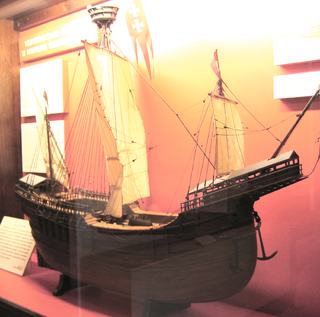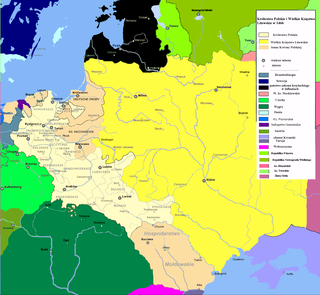
The Hanseatic League was a medieval commercial and defensive network of merchant guilds and market towns in Central and Northern Europe. Growing from a few North German towns in the late 12th century, the League expanded between the 13th and 15th centuries and ultimately encompassed nearly 200 settlements across eight modern-day countries, ranging from Estonia in the north and east, to the Netherlands in the west, and extended inland as far as Cologne, the Prussian regions and Kraków, Poland.

Lübeck, officially the Hanseatic City of Lübeck, is a city in Northern Germany. With around 220,000 inhabitants, it is the second-largest city on the German Baltic coast and the second-largest city in the state of Schleswig-Holstein, after its capital of Kiel, and is the 36th-largest city in Germany.
Albrecht Giese was a councilman and diplomat of the city of Danzig (Gdańsk). He was a member of the Hanseatic League, and part of an important merchant family who had offices in London and Danzig.

The Treaty of Stralsund ended the Danish-Hanseatic War between the Hanseatic League and the kingdom of Denmark. The Hanseatic League reached the peak of its power by the conditions of this treaty.

The State of the Teutonic Order was a theocratic state, located along the southeastern shore of the Baltic Sea in northern Europe. It was formed by the knights of the Teutonic Order during the early 13th century Northern Crusades in the region of Prussia. In 1237, the Livonian Brothers of the Sword merged with the Teutonic Order of Prussia and became known as its branch — the Livonian Order. At its greatest territorial extent during the early 15th century, the State encompassed Chełmno Land, Courland, Gotland, Livonia, Estonia, Neumark, Pomerelia, Prussia and Samogitia.
The Skåne Market or Scania market was a major fish market for herring which took place annually in Scania during the Middle Ages. From around 1200, it became one of the most important events for trade around the Baltic Sea and made Scania into a major distribution center for West-European goods bound for eastern Scandinavia. The Scania Market continued to be an important trade center for 250 years and was a cornerstone of the Hanseatic League's wealth.
The Steelyard, from the Middle Low German Stâlhof, was the kontor of the Hanseatic League in London, and their main trading base in England, from the 13th and 16th centuries. The main goods that the League exported from London were wool and from the 14th century woollen cloths. An important import good was beeswax. The kontor tended to be dominated by Rhenish and Westphalian traders, especially from Cologne.

The Lübeck law was the family of codified municipal law developed at Lübeck, which became a free imperial city in 1226 and is located in present-day Schleswig-Holstein. It was the second most prevalent form of municipal law in medieval and early modern Germany next to the Magdeburg Law.

The Dutch–Hanseatic War was a conflict between the County of Holland, acting independently of the rest of the Burgundian Netherlands of which it formed part, and the Hanseatic League. It led to little actual fighting, with a Dutch fleet patrolling Øresund while a Hanseatic fleet blocked their access to the Baltic Sea. It ended after Eric of Pomerania was forced from the throne of Denmark in 1440, and the new king Christopher of Bavaria sought a resolution. Peace was concluded in 1441 with the Treaty of Copenhagen.
The Treaty of Copenhagen was signed in 1441 between the Hanseatic League and the Burgundian Netherlands, ending the Dutch-Hanseatic War.
Paul Beneke, also Paul Benecke, was a German town councillor of Danzig and a privateer who was associated with the Hanseatic League.

Peter von Danzig was a 15th-century ship of the Hanseatic League. The three-masted ship was the first large vessel in the Baltic Sea with carvel planking.

The Confederation of Cologne was a medieval military alliance formed to combat the Kingdom of Denmark. It was established on November 19, 1367 by several cities in the Hanseatic League, several cities in Holland and Zeeland, and towns in Zuiderzee.
The Anglo-Hanseatic War was a conflict fought between England and the Hanseatic League, led by the cities of Danzig and Lübeck, that lasted from 1469 to 1474. Causes of the war include increasing English pressure against the trade of the Hanseatic cities on the southern coast of the Baltic Sea.

Johann Wittenborg was a merchant and mayor of the free port of Lübeck in what is now north Germany. He was admiral of the Hanseatic fleet at the Battle of Helsingborg and was tried and beheaded after losing this battle.

The Dano-Hanseatic War, also known as the Kalmar War with the Hanseatic League, or the Danish-Hanseatic War of 1426-1435, was an armed trade conflict between the Danish-dominated Kalmar Union and the Hanseatic League led by the Free City of Lübeck.
Baltic maritime trade began in the Late Middle Ages and continued to develop into the early modern period. During this time, ships carrying goods from the Baltic and North Sea passed along the Øresund, or the Sound, connecting areas like the Gulf of Finland to the Skagerrak. Over a period of 400 years, maritime powers in the east and west struggled to control these markets and the trade routes between them. The Baltic trading system of this era can be explained as beginning with the Hanseatic League and ending with the Great Nordic War.

Pskov has always played a special role in Russian trade with the West. Archaeological data shows the presence of imported goods in Pskov in the 10th and 11th centuries. This was due to the extensive trade contacts of Russian cities with Scandinavia, which was the source of Russian military elite since the 10th century. Archaeological excavation of Pskov necropolis in 2003 - 2004 revealed a high social status and Scandinavian origin of the buried. Large variety of around 60 found articles, among them Byzantine coins, bronze and copper items, confirms that Pskov was not an economically isolated region and shows extensive military and trade contacts with both the West and the East.
The Kontor of Bruges was the Hanseatic kontor, one of the Hanseatic League's four major trading posts, in Bruges, County of Flanders. A kontor was a corporation (universitas) with a level of legal autonomy in a foreign non-Hanseatic city, the one of Bruges was formally organised in the 14th century. Bruges was a major Flemish port in the high and late Middle Ages. Flanders was a fiefdom of France until 1493, after that it belonged to the Holy Roman Empire.

The Danish-Hanseatic War (1361–1370) was both a trade and territorial conflict mainly between the Kingdom of Denmark, led by King Valdemar IV, and the Hanseatic League, the latter of which was led by the rich and powerful merchant city of Lübeck. Though the first few years of the war resulted in several Danish victories, and even led to a beneficial truce for Denmark in 1365, the Hanseatic League, furious at the terms of the truce, resumed hostilities along with several allies and managed to defeat the Danes.












